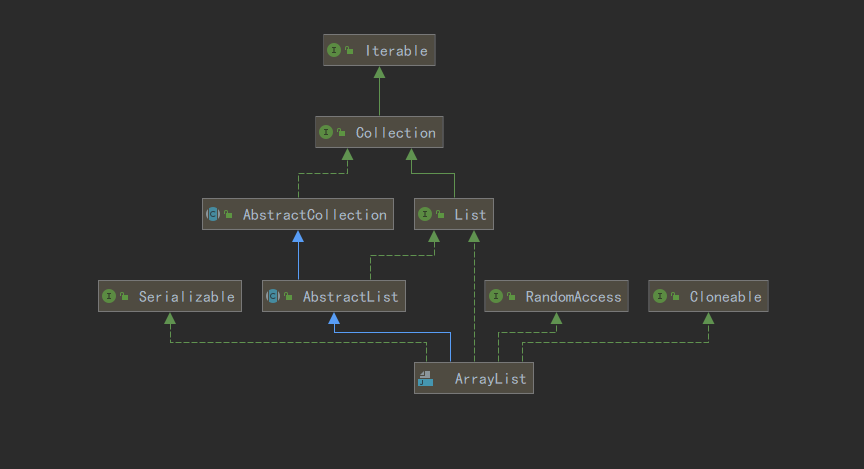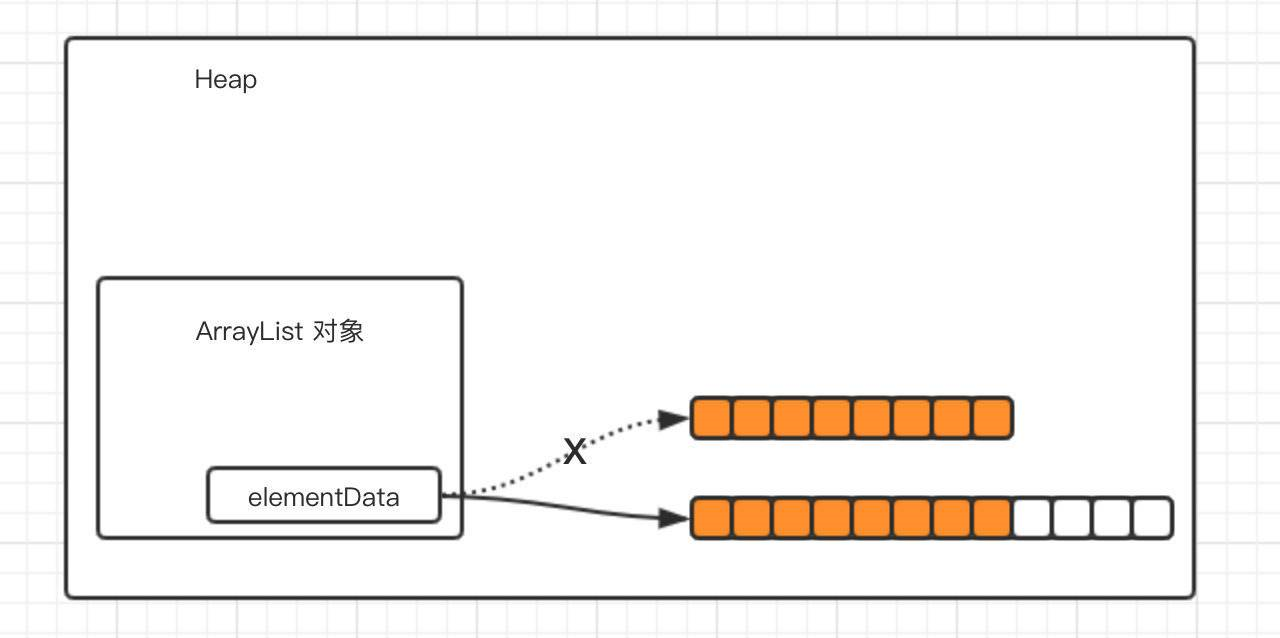ArrayList(数组)
ArrayList 是最常用的 List 实现类,内部是通过数组实现的,它允许对元素进行快速随机访问。数组的缺点是每个元素之间不能有间隔,当数组大小不满足时需要增加存储能力,就要将已经有数据的数组复制到新的存储空间中。当从 ArrayList 的中间位置插入或者删除元素时,需要对数组进行复制、移动、代价比较高。因此,他适合随机查找和遍历,不适合插入和删除。

从上图可以看出 ArrayList 继承了 AbstractList, 直接实现了 Cloneable, Serializable,RandomAccess 类型标志接口。
- AbstractList 作为列表的抽象实现,将元素的增删改查都交给了具体的子类去实现,在元素的迭代遍历的操作上提供了默认实现。
- Cloneable 接口的实现,表示了 ArrayList 支持调用 Object 的
clone方法,实现 ArrayList 的拷贝。 - Seriaizable 接口实现,表示 ArrayList 还支持序列化和反序列化操作,具有固定的
serialVersionUID属性值。 - RandomAccess 接口实现,表示 ArrayList 里的元素可以被高效率的随机访问,以下标数字的方式获取元素。实现 RandomAccess 接口的列表上在遍历时可直接使用普通的 for 循环方式,并且执行效率上给迭代器方式更高。
源码分析
ArrayList 有两个非常重要的成员变量:elementData 和 size。
/**
* Default initial capacity.
* 默认初始容量
*/
private static final int DEFAULT_CAPACITY = 10;
/**
* Shared empty array instance used for empty instances.
*/
private static final Object[] EMPTY_ELEMENTDATA = {};
/**
* Shared empty array instance used for default sized empty instances. We
* distinguish this from EMPTY_ELEMENTDATA to know how much to inflate when
* first element is added.
*/
private static final Object[] DEFAULTCAPACITY_EMPTY_ELEMENTDATA = {};
/**
* The array buffer into which the elements of the ArrayList are stored.
* The capacity of the ArrayList is the length of this array buffer. Any
* empty ArrayList with elementData == DEFAULTCAPACITY_EMPTY_ELEMENTDATA
* will be expanded to DEFAULT_CAPACITY when the first element is added.
*/
transient Object[] elementData; // non-private to simplify nested class access
/**
* The size of the ArrayList (the number of elements it contains).
* ArrayList的大小(包含元素个数)
* @serial
*/
private int size;elementData是一个 Object 数组,存放的元素,正是外部需要存放到 ArrayList 的元素,即 ArrayList 对象维护着这个对象数组 Object[],对外提供的增删改查以及遍历都是与这个数组有关,也因此添加到 ArrayList 的元素都是有序地存储在数组对象elementData中。size字段表示着当前添加到 ArrayList 的元素个数,需要注意的是它必定小于等于数组对象elementData的长度。一旦size与elementData长度相同,并且还在往列表添加元素时,ArrayList 就会执行扩容操作,用一个更长的数组对象存储先前的元素。
因为底层维护的是一个对象数组,所以向 ArrayList 集合添加的元素自然是可以重复的,允许为 null 的,并且它们的索引位置各不一样。
如何扩容
上诉中,已经说到当 size 字段与 elementData 长度相同时,此时再添加元素到集合中就会出现容量不够的情况,需要进行扩容,也就是说 ArrayList 的扩容操作发生在添加方法中,并且满足一定条件时才会发生。

/**
* Appends the specified element to the end of this list.
* 向列表末尾追加元素
* @param e element to be appended to this list
* @return <tt>true</tt> (as specified by {@link Collection#add})
*/
public boolean add(E e) {
ensureCapacityInternal(size + 1); // Increments modCount!!
elementData[size++] = e;
return true;
}从上面可以看出第三行代码是简单地添加单个元素,并让 size 递增加 1;那么扩容实现就在 ensureCapacityInternal 方法中,这里传入参数为 size+1,就是要在真正添加元素前判断添加后的元素个数,也就是集合所需要的最小容量是否会超过原数组的长度。再看下这个 ensureCapacityInternal 方法实现。
private void ensureCapacityInternal(int minCapacity) {
ensureExplicitCapacity(calculateCapacity(elementData, minCapacity));
}其内部仍有两个方法调用,首先看下比较简单的 calculateCapacity 方法:
private static int calculateCapacity(Object[] elementData, int minCapacity) {
if (elementData == DEFAULTCAPACITY_EMPTY_ELEMENTDATA) {
return Math.max(DEFAULT_CAPACITY, minCapacity);
}
return minCapacity;
}当 elementData 与 DEFAULTCAPACITY_EMPTY_ELEMENTDATA 相等,也就是空数组时,返回一个可添加元素的默认最小容量值 DEFAULT_CAPACITY 对应的10 ,否则按照传入的 size +1 为最小容量值;执行完之后接着看 ensureExplicitCapacity 方法:
private void ensureExplicitCapacity(int minCapacity) {
modCount++;
// overflow-conscious code
if (minCapacity - elementData.length > 0)
grow(minCapacity);
}从代码中可以看到扩容实现在 grow 方法之中,并且只有当数组长度小于所需要的最小容量时执行:当数组存储元素已满,无法再存储将新加入的元素。
/**
* Increases the capacity to ensure that it can hold at least the
* number of elements specified by the minimum capacity argument.
* 增加容量以确保它至少可以容纳最小容量参数指定的元素数。
* @param minCapacity the desired minimum capacity
*/
private void grow(int minCapacity) {
// overflow-conscious code
int oldCapacity = elementData.length;
// 扩容 1.5 倍
int newCapacity = oldCapacity + (oldCapacity >> 1);
if (newCapacity - minCapacity < 0)
// 扩容后都还小于minCapacity,说明当前数组为空
newCapacity = minCapacity;
if (newCapacity - MAX_ARRAY_SIZE > 0)
newCapacity = hugeCapacity(minCapacity);
// minCapacity is usually close to size, so this is a win:
elementData = Arrays.copyOf(elementData, newCapacity);
}进一步跳转到 grow 方法的实现,可以看到第8行利用工具类方法 java.util.Arrays#copyOf(T[], int) ,对原有数组进行拷贝,将内部所有的元素存放到长度为 newCapacity 的新数组中,并将对应新数组的引用赋值给 elementData。此刻 ArrayList 内部引用的对象就是更新长度了的新数组,实现效果就如下图一样:

现在我们再来关注下代表数组新容量的 newCapacity 被调整为多少。首先 newCapacity 通过 oldCapacity + (oldCapacity >> 1) 计算获得,使用位运算将原容量值 oldCapacity 通过右移一位,获得其一半的值(向下取整), 然后加上原来的容量值,那么就是原容量值 oldCapacity 的1.5倍。
当计算得到的newCapacity仍然小于传入最小容量时,说明当前数组个数为空,采用默认的DEFAULT_CAPACITY作为容量值分配数组。
数组默认最大值,MAX_ARRAY_SIZE定义如下:
/**
* The maximum size of array to allocate.
* Some VMs reserve some header words in an array.
* Attempts to allocate larger arrays may result in
* OutOfMemoryError: Requested array size exceeds VM limit
*/
private static final int MAX_ARRAY_SIZE = Integer.MAX_VALUE - 8;当newCapacity大于MAX_ARRAY_SIZE时,执行方法hugeCapacity :
private static int hugeCapacity(int minCapacity) {
if (minCapacity < 0) // overflow
throw new OutOfMemoryError();
return (minCapacity > MAX_ARRAY_SIZE) ?
Integer.MAX_VALUE :
MAX_ARRAY_SIZE;
}从hugeCapacity中可知,ArrayList 最大容量为Integer.MAX_VALUE,所以当存储元素个数超出这个限制时,就会产生OutOfMemoryError错误。
其实在其它添加元素的方法里实现我们都可以看到ensureCapacityInternal方法的调用,在真正操作底层数组前都会进行容量的确认,容量不够则进行动态扩容。

序列化与反序列化
/**
* The array buffer into which the elements of the ArrayList are stored.
* The capacity of the ArrayList is the length of this array buffer. Any
* empty ArrayList with elementData == DEFAULTCAPACITY_EMPTY_ELEMENTDATA
* will be expanded to DEFAULT_CAPACITY when the first element is added.
*/
transient Object[] elementData; // non-private to simplify nested class access通常transient关键字修饰的字段表示该字段不会被序列化,但是 ArrayList 实现了序列化接口,并且提供了序列化方法writeObject与反序列化readObject的实现,如下:
/**
* Save the state of the <tt>ArrayList</tt> instance to a stream (that
* is, serialize it).
*
* @serialData The length of the array backing the <tt>ArrayList</tt>
* instance is emitted (int), followed by all of its elements
* (each an <tt>Object</tt>) in the proper order.
*/
private void writeObject(java.io.ObjectOutputStream s)
throws java.io.IOException{
// Write out element count, and any hidden stuff
int expectedModCount = modCount;
// 将当前对象的非 static 修饰,非 transient 修饰的字段写出到流中
s.defaultWriteObject();
// Write out size as capacity for behavioural compatibility with clone()
// 将 ArrayList 元素个数作为输出容量大小
s.writeInt(size);
// Write out all elements in the proper order.
for (int i=0; i<size; i++) {
s.writeObject(elementData[i]);
}
if (modCount != expectedModCount) {
throw new ConcurrentModificationException();
}
}在反序列化中,现根据读进来的流数据中获取 size 属性,然后进行数组扩容,最后将数据流中读到的所有元素数据存放到特有的对象数组中。
/**
* Reconstitute the <tt>ArrayList</tt> instance from a stream (that is,
* deserialize it).
*/
private void readObject(java.io.ObjectInputStream s)
throws java.io.IOException, ClassNotFoundException {
elementData = EMPTY_ELEMENTDATA;
// Read in size, and any hidden stuff
s.defaultReadObject();
// Read in capacity
s.readInt(); // ignored
if (size > 0) {
// be like clone(), allocate array based upon size not capacity
int capacity = calculateCapacity(elementData, size);
SharedSecrets.getJavaOISAccess().checkArray(s, Object[].class, capacity);
ensureCapacityInternal(size);
Object[] a = elementData;
// Read in all elements in the proper order.
for (int i=0; i<size; i++) {
a[i] = s.readObject();
}
}
}关于拷贝
针对列表元素的拷贝,ArrayList 提供自定义的 clone 实现如下:
/**
* Returns a shallow copy of this <tt>ArrayList</tt> instance. (The
* elements themselves are not copied.)
* 返回此ArrayList实例的浅表副本。 (元素本身不会被复制。)浅拷贝
* @return a clone of this <tt>ArrayList</tt> instance
*/
public Object clone() {
try {
ArrayList<?> v = (ArrayList<?>) super.clone();
v.elementData = Arrays.copyOf(elementData, size);
v.modCount = 0;
return v;
} catch (CloneNotSupportedException e) {
// this shouldn't happen, since we are Cloneable
throw new InternalError(e);
}
}从上述代码可以清楚看出执行的copyOf操作是一次浅拷贝操作,原 ArrayList 对象的元素不会被拷贝一份存入到新的 ArrayList 对象中返回,它们各自的字段elementData里各位置存放的都是一样的元素引用,一旦某个列表修改了数据,另一个列表也会跟着改变。
JDK 1.8 后的 ArrayList
新增 removeIf() 方法
removeIf()是 Collection 接口新增的接口方法,ArrayList 由于父类实现该接口,所以也有这个方法。removeIf()方法用于进行指定条件的从数组中删除元素。@Override public boolean removeIf(Predicate<? super E> filter) { Objects.requireNonNull(filter); // figure out which elements are to be removed // any exception thrown from the filter predicate at this stage // will leave the collection unmodified int removeCount = 0; final BitSet removeSet = new BitSet(size); final int expectedModCount = modCount; final int size = this.size; for (int i=0; modCount == expectedModCount && i < size; i++) { @SuppressWarnings("unchecked") final E element = (E) elementData[i]; if (filter.test(element)) { removeSet.set(i); removeCount++; } } if (modCount != expectedModCount) { throw new ConcurrentModificationException(); } // shift surviving elements left over the spaces left by removed elements final boolean anyToRemove = removeCount > 0; if (anyToRemove) { final int newSize = size - removeCount; for (int i=0, j=0; (i < size) && (j < newSize); i++, j++) { i = removeSet.nextClearBit(i); elementData[j] = elementData[i]; } for (int k=newSize; k < size; k++) { elementData[k] = null; // Let gc do its work } this.size = newSize; if (modCount != expectedModCount) { throw new ConcurrentModificationException(); } modCount++; } return anyToRemove; }传入一个代表条件的函数式接口参数
Predicate,也就是 Lambda 表达式进行条件匹配,如果条件为true,则将该元素从数组中删除,例:List<Integer> list = new ArrayList<>(Arrays.asList(1,3,5,1,5,6,4,5,8,45,2,5,5)); list.removeIf(l -> l == 5); System.out.println(list); // [1, 3, 1, 6, 4, 8, 45, 2]新增 spliterator 方法
这个方法也是来自 Collection 接口,ArrayList 对此方法进行了重写。该方法会返回 ListSpliterator 实例,该实例用于遍历和分离容器所存储的元素。
/** * Creates a <em><a href="Spliterator.html#binding">late-binding</a></em> * and <em>fail-fast</em> {@link Spliterator} over the elements in this * list. * * <p>The {@code Spliterator} reports {@link Spliterator#SIZED}, * {@link Spliterator#SUBSIZED}, and {@link Spliterator#ORDERED}. * Overriding implementations should document the reporting of additional * characteristic values. * * @return a {@code Spliterator} over the elements in this list * @since 1.8 */ @Override public Spliterator<E> spliterator() { return new ArrayListSpliterator<>(this, 0, -1, 0); }在 ArrayList 的实现中,改方法返回一个内部静态类对象 ArrayListSpliterator,通过它可以对集合元素进行操作。
它的主要操作方法有:
tryAdvance迭代单个元素,类似于iterator.next()forEachRemaining迭代剩余元素trySplit将元素切分成为两部分并行处理,但需要注意 Spliterator 并不是线程安全的。
虽然这三个方法并不常用,但还是有必要了解一下,使用案例:
List<Integer> list = new ArrayList<>(Arrays.asList(1, 3, 5, 1, 5, 6, 4, 5, 8, 45, 2, 5, 5)); Spliterator<Integer> spliterator = list.spliterator(); // 迭代单个元素,类似于 iterator.next() spliterator.tryAdvance(System.out::println); // 1 // 迭代剩余元素 spliterator.forEachRemaining(o -> System.out.print(o + " ")); // 3 5 1 5 6 4 5 8 45 2 5 5 // 将元素切分成为两部分并行处理 Spliterator<Integer> trySplit = spliterator.trySplit(); trySplit.forEachRemaining(o -> System.out.print(o + " ")); // 3 5 1 5 6 4 spliterator.forEachRemaining(o -> System.out.print(o + " ")); // 5 8 45 2 5 5
高效初始化
ArrayList 实现了三个构造函数,默认创建时会分配到空数组对象EMPTY_ELEMENTDATA;第二个是传入一个集合类型数据进行初始化;第三个允许传入集合长度的初始化值,也就是数组长度。由于每次数组长度不够会导致扩容,重新申请更长的内存空间,并进行复制。而让我们初始化 ArrayList 指定数组初始大小,可以减少数组的扩容次数,提高性能。
/**
* Constructs an empty list with the specified initial capacity.
*
* @param initialCapacity the initial capacity of the list
* @throws IllegalArgumentException if the specified initial capacity
* is negative
*/
public ArrayList(int initialCapacity) {
if (initialCapacity > 0) {
this.elementData = new Object[initialCapacity];
} else if (initialCapacity == 0) {
this.elementData = EMPTY_ELEMENTDATA;
} else {
throw new IllegalArgumentException("Illegal Capacity: "+ initialCapacity);
}
}
/**
* Constructs an empty list with an initial capacity of ten.
*/
public ArrayList() {
this.elementData = DEFAULTCAPACITY_EMPTY_ELEMENTDATA;
}
/**
* Constructs a list containing the elements of the specified
* collection, in the order they are returned by the collection's
* iterator.
*
* @param c the collection whose elements are to be placed into this list
* @throws NullPointerException if the specified collection is null
*/
public ArrayList(Collection<? extends E> c) {
elementData = c.toArray();
if ((size = elementData.length) != 0) {
// c.toArray might (incorrectly) not return Object[] (see 6260652)
if (elementData.getClass() != Object[].class)
elementData = Arrays.copyOf(elementData, size, Object[].class);
} else {
// replace with empty array.
this.elementData = EMPTY_ELEMENTDATA;
}
}元素遍历
JDK 1.8 前,ArrayList 只支持 3 种遍历方式:迭代器遍历,普通 for 循环,for-each 增强,在 JDK 1.8 引入了 Stream API 之后,同属于 Collection 集合的 ArrayList 可以使用 stream.foreach()方法一个个地获取元素:
ArrayList<String> names = new ArrayList<String>(Arrays.asList( "alex", "brian", "charles"));
names.forEach(name -> System.out.println(name)); // alex brian charles转换 Array
ArrayList 提供两个方法用于列表向数组的转换
/**
* Returns an array containing all of the elements in this list
* in proper sequence (from first to last element).
*
* <p>The returned array will be "safe" in that no references to it are
* maintained by this list. (In other words, this method must allocate
* a new array). The caller is thus free to modify the returned array.
*
* <p>This method acts as bridge between array-based and collection-based
* APIs.
*
* @return an array containing all of the elements in this list in
* proper sequence
*/
public Object[] toArray() {
return Arrays.copyOf(elementData, size);
}
/**
* Returns an array containing all of the elements in this list in proper
* sequence (from first to last element); the runtime type of the returned
* array is that of the specified array. If the list fits in the
* specified array, it is returned therein. Otherwise, a new array is
* allocated with the runtime type of the specified array and the size of
* this list.
*
* <p>If the list fits in the specified array with room to spare
* (i.e., the array has more elements than the list), the element in
* the array immediately following the end of the collection is set to
* <tt>null</tt>. (This is useful in determining the length of the
* list <i>only</i> if the caller knows that the list does not contain
* any null elements.)
*
* @param a the array into which the elements of the list are to
* be stored, if it is big enough; otherwise, a new array of the
* same runtime type is allocated for this purpose.
* @return an array containing the elements of the list
* @throws ArrayStoreException if the runtime type of the specified array
* is not a supertype of the runtime type of every element in
* this list
* @throws NullPointerException if the specified array is null
*/
@SuppressWarnings("unchecked")
public <T> T[] toArray(T[] a) {
if (a.length < size)
// Make a new array of a's runtime type, but my contents:
return (T[]) Arrays.copyOf(elementData, size, a.getClass());
System.arraycopy(elementData, 0, a, 0, size);
if (a.length > size)
a[size] = null;
return a;
}- 第一个方法直接返回 Object 类型数组
- 在第二个方法中,返回数组的类型为所传入的指定数组的类型。并且如果列表的长度符合传入的数组,将元素拷贝到数组后并返回。否则,将根据传入数组的类型和列表的大小重新分配一个新数组,拷贝完成后返回。
从上述描述可以看出使用第二个方法更加合适,能保留原先的数据类型:
ArrayList<String> list = new ArrayList<>(4);
list.add("A");
list.add("B");
list.add("C");
list.add("D");
String[] array = list.toArray(new String[list.size()]);
System.out.println(Arrays.toString(array)); // [A, B, C, D]应对多线程
ArrayList 本身是非线程安全的,如果需要使用线程安全的列表通常采用的方式是java.util.Collections#synchronizedList(java.util.List<T>) 或者 使用 Vector 类代替。还有一种方式是使用并发容器类CopyOnWriteArrayList在多线程中使用,它底层通过创建原数组的副本来实现更新,不仅线程安全,同时减少了对线程的同步操作。
应对头部节点的增删
ArrayList是数组实现的,使用的是连续的内存空间,当有需要在数组头部进行元素的添加或删除操作的时候,需要对目标元素以后的元素进行复制并重新排序,效率很低。针对有大量类似操作的场景,出于性能考虑,我们应该使用LinkedList代替。因为 LinkedList 是基于链表实现,当我们需要操作的目标元素处于整个链表的前半段时,可直接通过遍历的方式查询目标元素,然后进行元素的增删操作。
